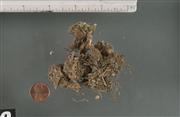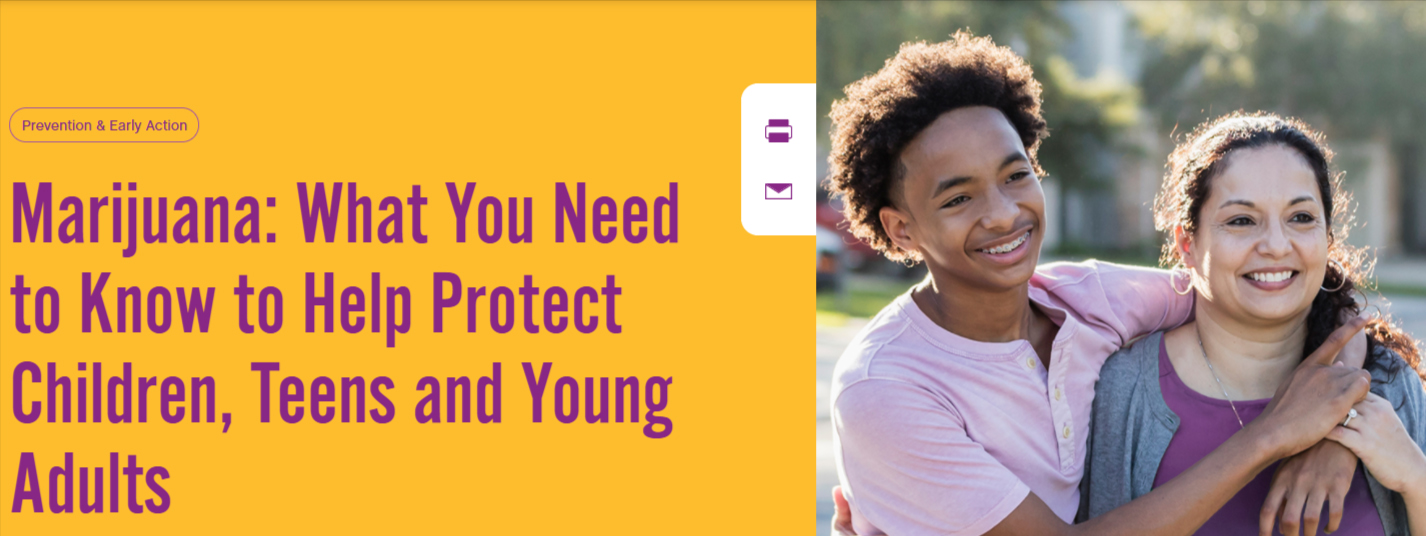Marijuana
 What are the street names/slang terms for marijuana?
What are the street names/slang terms for marijuana?
Weed, Pot, Reefer, Grass, Dope, Ganja, Mary Jane, Hash, Herb, Aunt Mary, Skunk, Boom, Chronic, Cheeba, Blunt, Ganja, Roach, Jolly Green
What is marijuana and what does it look like?
Marijuana is a greenish-gray mixture of the dried, shredded leaves, stems, seeds, and flowers of Cannabis sativa—the hemp plant. It grows wild in many of the tropical and temperate areas of the world. It can be grown in almost any climate, and is increasingly cultivated by means of indoor hydroponic technology.
The main active ingredient in cannabis is called delta-9 tetrahydro-cannabinol, commonly known as THC. This is the part of the plant that gives the "high." There is a wide range of THC potency between cannabis products.
How is it used?
Most users smoke marijuana in hand-rolled cigarettes called joints, among other names; some use pipes or water pipes called bongs. Marijuana cigars, or blunts, are also popular. To make blunts, users slice open cigars, remove some of the tobacco, and mix the remainder with marijuana. Marijuana also is used to brew tea and sometimes is mixed into foods.
What are its short-term effects?
The short-term effects of using cannabis may include:
- Feeling of well-being
- Talkativeness;
- Drowsiness;
- Loss of inhibitions;
- Decreased nausea;
- Increased appetite;
- Loss of co-ordination;
- Bloodshot eyes;
- Dryness of the eyes mouth, and throat;
- Anxiety and paranoia.
What are its long-term effects?
There is limited research on the long-term effects of cannabis. On the available evidence, the major probable adverse effects are:
- Increased risk of respiratory diseases associated with smoking, including cancer;
- Decreased memory and learning abilities;
- Decreased motivation in areas such as study, work or concentration.
There is also much concern about the link between cannabis use and mental health problems and the risk of dependence.
What is its federal classification?
Schedule I
Source
National Institute on Drug Abuse (NIDA)
-

More Than Just Music Has Changed Since the 90's.pdf
PDFNJ25_90sBoomboxCanbsCamp_IS_ECOPoster_10'7x22'10_V1_PRINT.pdf
-

More Than Just Music Has Changed Since the 90's.pdf
PDFNJ25_90sBoomboxCanbsCamp_IS_Vinyl Bulletin_14x48_V1_PRINT.pdf
-

More Than Just Music Has Changed Since the 90's.pdf
PDFNJ25_90sBoomboxCanbsCamp_IS_Vinyl Poster_12x25_V1_PRINT.pdf
-

More Than Just Music Has Changed Since the 90's.pdf
PDFNJ25_90sBoomboxCanbsCamp_Verde_Billboard_14x48_V1_PRINT.pdf
-

Teen Marijuana Use.pdf
PDFNJ24_CannabisCamp_College_Print_132x60_JuniorPoster_Eng.pdf
-

Teen Marijuana Use - ESPANOL.pdf
PDFNJ24_CannabisCamp_College_Print_132x60_JuniorPoster_Span.pdf
-

Teen Marijuana Use.pdf
PDFNJ24_CannabisCamp_Fentanyl_Print_132x60_JuniorPoster_Eng.pdf
-

Teen Marijuana Use.pdf
PDFNJ24_CannabisCamp_Track_Print_132x60_JuniorPoster_Eng.pdf
-

Teen Marijuana Use.pdf
PDFNJ24_CannabisCamp_Track_Print_132x60_JuniorPoster_Span.pdf
-

Teen Marijuana Use - ESPANOL.jpg
PDFNJ24_CannibCampDig_PDFNJ Video Screen PSA 1920x1080- Bball_Span.jpg
-

Teen Marijuana Use - ESPANOL.jpg
PDFNJ24_CannibCampDig_PDFNJ Video Screen PSA 1920x1080- College_Span.jpg
-

Teen Marijuana Use.jpg
PDFNJ24_CannibCampDig_PDFNJ Video Screen PSA 1920x1080- College_Eng.jpg
What You Need to Know About Marijuana Use in Teens
Fast Facts

- 38% of high school students report having used marijuana in their life.1
-
Research shows that marijuana use can have permanent effects on

the developing brain when use begins in adolescence, especially with regular or heavy use.2
-
Frequent or long-term marijuana

use is linked to school
dropout and lower educational achievement.3
The teen years are a time of rapid growth, exploration, and onset of risk taking. Taking risks with new behaviors provides kids and teens the opportunity to test their skills and abilities and discover who they are. But, some risk behaviors—such as using marijuana—can have harmful and long-lasting effects on a teen’s health and well-being.
Marijuana and the teen brain
Unlike adults, the teen brain is actively developing and often will not be fully developed until the mid 20s. Marijuana use during this period may harm the developing teen brain.
Negative effects include:
- Difficulty thinking and problem solving.
- Problems with memory and learning.
- Impaired coordination.
- Difficulty maintaining attention.3
Negative effects on school and social life
Marijuana use in adolescence or early adulthood can have a serious impact on a teen’s life.
- Decline in school performance. Students who smoke marijuana may get lower grades and may more likely to drop out of high school than their peers who do not use.4
- Increased risk of mental health issues. Marijuana use has been linked to a range of mental health problems in teens such as depression or anxiety.5 Psychosis has also been seen in teens at higher risk like those with a family history.6
- Impaired driving. Driving while impaired by any substance, including marijuana, is dangerous. Marijuana negatively affects a number of skills required for safe driving, such as reaction time, coordination, and concentration.7, 8
- Potential for addiction.a Research shows that about 1 in 6 teens who repeatedly use marijuana can become addicted, which means that they may make unsuccessful efforts to quit using marijuana or may give up important activities with friends and family in favor of using marijuana.
For more information, visit:
Cannabis Use During Adolescence and Young Adulthood and Academic Achievement: https://www.cdc.gov/healthyyouth/data/yrbs/index.htm
YRBSS Results, Slides, and MMWR Publications: https://www.cdc.gov/healthyyouth/data/yrbs/index.htm
Parent Engagement Tips: https://www.cdc.gov/healthyyouth/protective/parent_engagement.htm
School Connectedness: https://www.cdc.gov/healthyyouth/protective/school_connectedness.htm
NIDA Drug Facts: Marijuana: https://teens.drugabuse.gov/drug-facts/marijuana
NIDA Marijuana: Facts for Teens: https://www.drugabuse.gov/publications/marijuana-facts-teens/letter-to-teens
Adolescents and Marijuana: http://learnaboutmarijuanawa.org/factsheets/adolescents.htm
References
a The term “addiction” is used to describe compulsive drug seeking despite negative consequences. However, we recognize that “addiction” is not considered a specific diagnosis in the fifth edition of The Diagnostic and Statistical Manual of Mental Disorders (DSM-5)—a diagnostic manual used by clinicians that contains descriptions and symptoms of all mental disorders classified by the American Psychiatric Association (APA). Rather the DSM-5 uses the term substance use disorder. However, throughout this document addiction is used synonymously with having a substance use disorder for ease of language recognition and understanding.
- Centers for Disease Control and Prevention (CDC), High School Youth Risk Behavior Survey Data. 2016 [cited 2016 November 16, 2016]; Available from: http://nccd.cdc.gov/youthonline/.
- National Institute on Drug Abuse. What are marijuana’s long-term effects on the brain? 2016 [cited 2016 November 16, 2016]; Available from: https://www.drugabuse.gov/publications/marijuana/what-are-marijuanas-long-term-effects-brain.
- Fergusson, D.M. and J.M. Boden, Cannabis use and later life outcomes. Addiction, 2008. 103(6): p. 969-76; discussion 977-8.
- Broyd, S.J., et al., Acute and Chronic Effects of Cannabinoids on Human Cognition-A Systematic Review. Biol Psychiatry, 2016. 79(7): p. 557-67.
- Copeland, J., S. Rooke, and W. Swift, Changes in cannabis use among young people: impact on mental health. Curr Opin Psychiatry, 2013. 26(4): p. 325-9.
- Arseneault, L., et al., Cannabis use in adolescence and risk for adult psychosis: longitudinal prospective study. BMJ, 2002. 325(7374): p. 1212-3.
- Bondallaz, P., et al., Cannabis and its effects on driving skills. Forensic Sci Int, 2016. 268: p.92-102.
- Hartman, R.L. and M.A. Huestis, Cannabis effects on driving skills. Clin Chem, 2013. 59(3): p. 478-92.
- National Institute on Drug Abuse. Drugs, Brains, and Behavior: The Science of Addiction 2014 [cited 2016 December 29]
